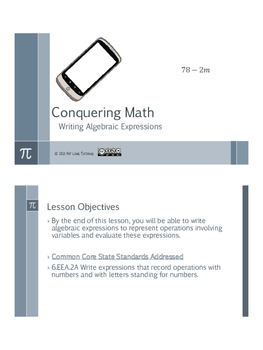Algebraic Expressions Bundle - Preview
278 Downloads
Conquering Math
92 Followers
Grade Levels
5th - 8th
Subjects
Resource Type
Standards
CCSS6.NS.B.4
CCSS6.EE.A.2a
CCSS6.EE.A.2b
CCSS6.EE.A.2c
CCSS6.EE.A.3
Formats Included
- Zip
Pages
N/A
Conquering Math
92 Followers
Description
Find the full version of this bundle on the Conquering Math website: https://goo.gl/8FTH2V
Your students will master algebraic expressions with this bundle of guided note sheets from Conquering Math! These note sheets can be used independently or with the Algebraic Expressions playlist.
Each set of guided note sheets will explain the relevant concepts and then take students through a set of clear step-by-step examples that build student understanding of towards mastery of the standards. Each set of notes also includes multiple problems for students to complete independently. Students can check their solutions to these problems through the Independent Practice Solutions video for each topic. The solutions videos can be found immediately following each lesson video in the playlist.
Please like Conquering Math on Facebook, and follow on Twitter and Google Plus.
Facebook: @ConqueringMathOfficial
Twitter: @Conquering_Math
Google+: Conquering Math
Youtube: www.youtube.com/conqueringmath
Your students will master algebraic expressions with this bundle of guided note sheets from Conquering Math! These note sheets can be used independently or with the Algebraic Expressions playlist.
Each set of guided note sheets will explain the relevant concepts and then take students through a set of clear step-by-step examples that build student understanding of towards mastery of the standards. Each set of notes also includes multiple problems for students to complete independently. Students can check their solutions to these problems through the Independent Practice Solutions video for each topic. The solutions videos can be found immediately following each lesson video in the playlist.
Please like Conquering Math on Facebook, and follow on Twitter and Google Plus.
Facebook: @ConqueringMathOfficial
Twitter: @Conquering_Math
Google+: Conquering Math
Youtube: www.youtube.com/conqueringmath
Total Pages
N/A
Answer Key
N/A
Teaching Duration
N/A
Report this resource to TPT
Reported resources will be reviewed by our team. Report this resource to let us know if this resource violates TPT’s content guidelines.
Standards
to see state-specific standards (only available in the US).
CCSS6.NS.B.4
Find the greatest common factor of two whole numbers less than or equal to 100 and the least common multiple of two whole numbers less than or equal to 12. Use the distributive property to express a sum of two whole numbers 1–100 with a common factor as a multiple of a sum of two whole numbers with no common factor. For example, express 36 + 8 as 4 (9 + 2).
CCSS6.EE.A.2a
Write expressions that record operations with numbers and with letters standing for numbers. For example, express the calculation “Subtract 𝘺 from 5” as 5 - 𝘺.
CCSS6.EE.A.2b
Identify parts of an expression using mathematical terms (sum, term, product, factor, quotient, coefficient); view one or more parts of an expression as a single entity. For example, describe the expression 2 (8 + 7) as a product of two factors; view (8 + 7) as both a single entity and a sum of two terms.
CCSS6.EE.A.2c
Evaluate expressions at specific values of their variables. Include expressions that arise from formulas used in real-world problems. Perform arithmetic operations, including those involving whole-number exponents, in the conventional order when there are no parentheses to specify a particular order (Order of Operations). For example, use the formulas V = s³ and A = 6 s² to find the volume and surface area of a cube with sides of length s = 1/2.
CCSS6.EE.A.3
Apply the properties of operations to generate equivalent expressions. For example, apply the distributive property to the expression 3 (2 + 𝘹) to produce the equivalent expression 6 + 3𝘹; apply the distributive property to the expression 24𝘹 + 18𝘺 to produce the equivalent expression 6 (4𝘹 + 3𝘺); apply properties of operations to 𝘺 + 𝘺 + 𝘺 to produce the equivalent expression 3𝘺.





